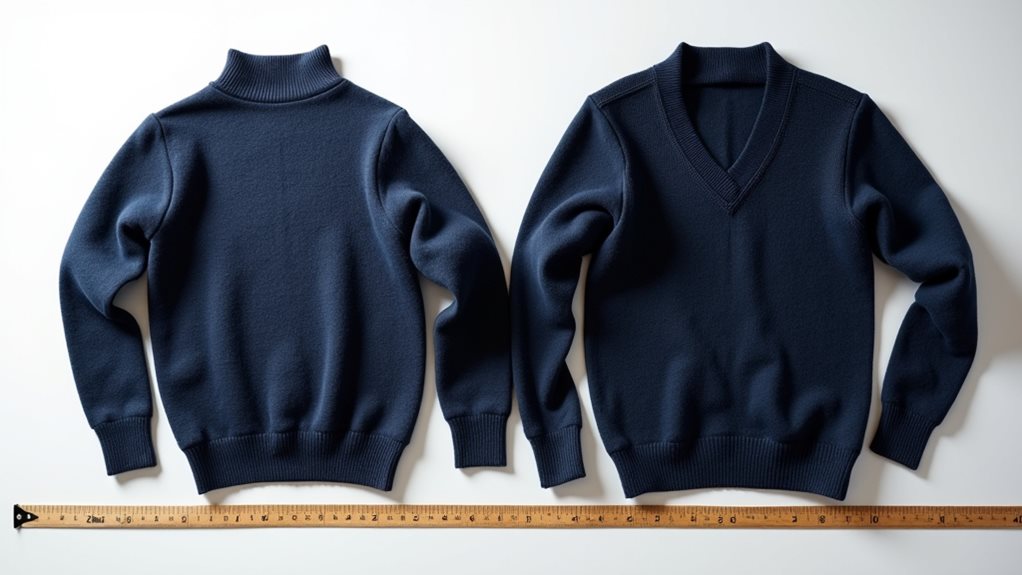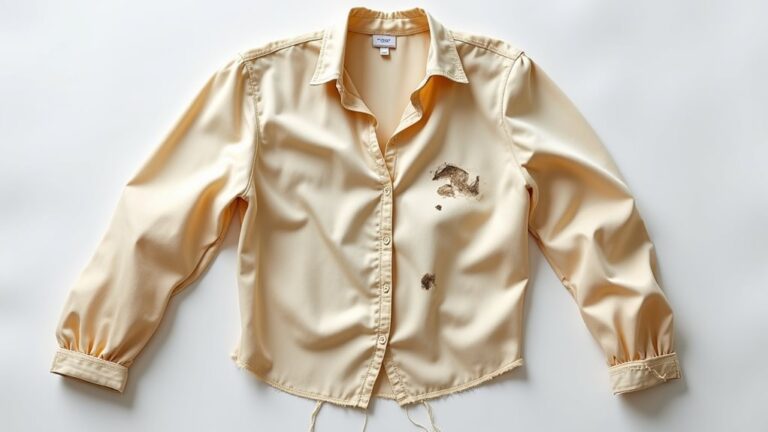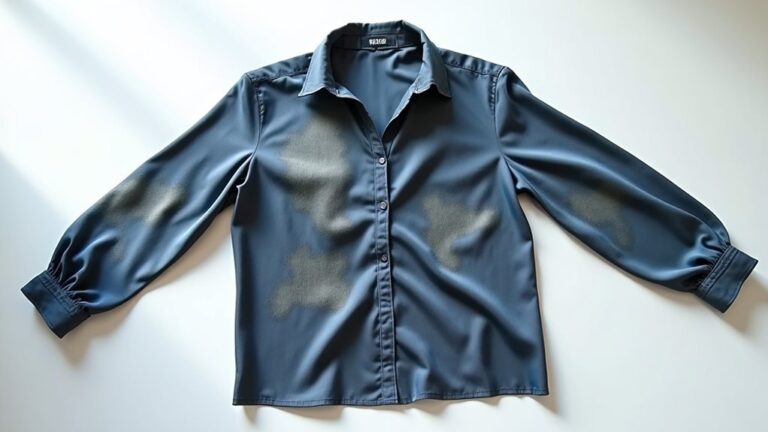You’ll be happy to know that dry cleaning actually protects your clothes from shrinkage, unlike traditional washing that can shrink natural fibers by up to 10%. The gentle solvent-based process eliminates water and high heat—the main culprits behind those “oops, my favorite sweater turned into doll clothes” moments we’ve all experienced. While machine malfunctions can occasionally cause issues, professional dry cleaning greatly reduces shrinkage risks compared to your home washer and dryer, and there’s much more to understand about keeping your garments safe.
Understanding the Science Behind Fabric Shrinkage
When you’ve ever pulled a favorite sweater from the dryer only to find it could now fit a toddler, you’ve witnessed the fascinating yet frustrating science of fabric shrinkage firsthand.
The culprits behind this wardrobe catastrophe are heat and agitation, which cause fibers to contract like they’re doing tiny yoga poses 🧘♀️. Natural fibers like cotton and wool are particularly dramatic performers in this shrinking show, while synthetic materials tend to keep their cool.
Your dryer’s heat releases tension in wet fibers, making them tighten up faster than your jeans after Thanksgiving dinner. While dry cleaning uses chemical solvents instead of water which typically reduces shrinkage risk, certain materials like wool and silk can still shrink if exposed to excessive heat during the cleaning or pressing stages. To prevent shrinkage disasters, always check that care label – it’s your fabric’s autobiography, telling you exactly how to treat it right and avoid the dreaded “Dry Cleaning Shrink” scenario.
How the Dry Cleaning Process Actually Works

When you drop off your favorite blazer at the dry cleaner, you’re actually witnessing a fascinating dance between chemistry and mechanical precision, where solvents replace water to gently lift away dirt and oils without the harsh agitation that makes your cotton shirts shrink in your home washer.
The magic happens when these specialized machines carefully control heat levels and gentle tumbling motions, creating just enough movement to circulate the cleaning solvent while treating your garments like they’re made of spun gold rather than everyday fabric.
What many people don’t realize is that the machine’s maintenance plays a vital role in this process, because when equipment isn’t properly calibrated, even the gentlest solvent can turn your perfectly fitted dress into something that looks like it belongs on your little sister! 😅
After the cleaning cycle completes, garments undergo solvent extraction and drying, followed by pressing and steaming to restore their original shape and appearance.
Solvent-Based Cleaning Method
Unlike traditional washing that relies on water and detergent, dry cleaning employs a sophisticated solvent-based method that’s honestly quite fascinating once you understand what’s happening behind those mysterious machines.
The dry cleaning process uses perchloroethylene, a powerful solvent that’s completely water-free, which means your clothes shrink far less frequently than they’d in your home washer. When you drop off that expensive blazer, it gets immersed in this chemical bath that dissolves dirt and stains without the aggressive agitation that causes shrinkage.
Professional dry cleaners understand that this gentle approach protects delicate fibers, especially wool and silk, from the high temperatures and tumbling action that make natural materials contract. However, shrinkage can still occur if wrong solvents are used for specific fabric types or if temperature control isn’t properly managed. It’s like giving your garments a spa day instead of boot camp!
Heat and Agitation Levels
Although dry cleaning machines might look intimidating from the outside, they’re actually designed to be remarkably gentle with your clothes, using controlled heat and minimal agitation that would make your home washer jealous.
Unlike your washing machine at home that tosses clothes around like a frustrated chef mixing ingredients, a dry cleaning machine operates with precision and restraint. The heat causes minimal stress because it’s carefully regulated, typically staying much lower than what you’d experience in conventional washing.
This controlled agitation means there’s considerably less shrinkage in dry cleaning compared to traditional methods. Your delicate fabrics get the spa treatment they deserve, with just enough movement to clean thoroughly without the harsh tumbling that can damage fibers and cause unwanted size changes.
The effectiveness of preventing shrinkage also depends on the fabric type, as natural fibers like wool, cotton, and silk respond differently to the dry cleaning process than synthetic materials.
Machine Maintenance Impact
Behind every successful dry cleaning operation lies a well-maintained machine that’s been calibrated with the precision of a Swiss watchmaker, because even the gentlest cleaning process can turn into a fabric nightmare when equipment starts acting up.
When dry cleaners skip machine maintenance, you’re fundamentally playing Russian roulette with your favorite cashmere sweater 😬.
Faulty chillers create excessive heat that’ll shrink garments faster than you can say “wardrobe malfunction,” while water leaks contaminate solvents and defeat the whole water-free advantage.
Quality dry cleaners understand this delicate dance, investing in routine calibration checks and equipment overhauls to prevent these costly mistakes.
That’s why choosing a reliable cleaner isn’t just about convenience—it’s about protecting your investment in beautiful clothing.
Ongoing costs like chemical supplies and equipment maintenance represent significant operational expenses that professional cleaners must manage to maintain both quality standards and profitability.
Common Myths About Dry Cleaning and Shrinkage Debunked

When I first started taking my favorite wool sweater to the dry cleaner, my grandmother warned me with that concerned look she reserved for truly dangerous activities like jaywalking or eating gas station sushi 🍣.
My grandmother’s pearl-clutching warnings about dry cleaning rivaled her concerns about jaywalking and questionable gas station cuisine choices.
“That dry cleaning will shrink your clothes to doll-size,” she insisted, clutching her pearls dramatically.
Here’s what I’ve learned after years of dry cleaning experience: this myth simply isn’t true.
Dry cleaning actually protects your garments from shrinkage because it uses solvents instead of water and heat, which are the real culprits behind fabric shrinkage.
Professional cleaners are trained to handle delicate materials with care, and they won’t worsen existing shrinkage like traditional washing methods might with their aggressive agitation and high temperatures.
In fact, dry cleaning is particularly beneficial for maintaining the original size and shape of delicate items like wool, silk, and structured clothing that are most prone to shrinkage damage.
Factors That Influence Shrinkage Risk During Dry Cleaning
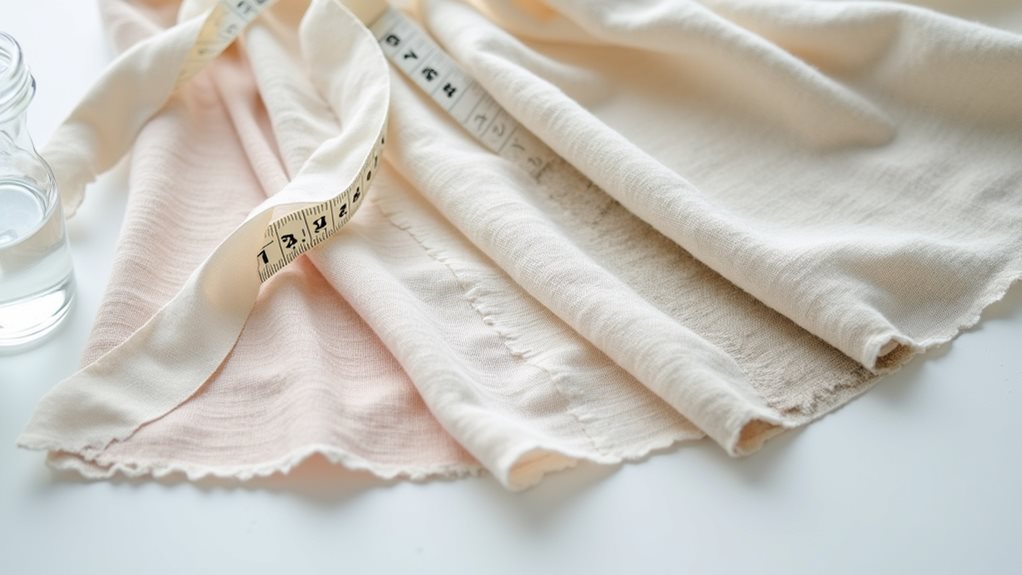
When you’re standing at the dry cleaner’s counter wondering if your favorite sweater might come back smaller, you’ll want to understand that certain factors stack the deck against you – and honestly, I learned this the hard way after my cashmere cardigan returned looking like it belonged to my niece 😅.
The type of fabric you’re dealing with plays a huge role in shrinkage risk, since natural fibers like cotton and wool are basically shrinkage magnets compared to their synthetic cousins like polyester, which tend to hold their shape through almost anything.
Beyond fabric composition, machine malfunctions that allow excessive heat to sneak into the process can turn your perfectly-fitted blazer into something that would make a Victorian woman proud of its restrictive fit, which is why choosing a reputable cleaner with well-maintained equipment isn’t just smart – it’s vital.
Professional dry cleaning uses chemical solvents instead of water and heat, which makes it generally safer for maintaining the original size and shape of delicate fabrics like silk and wool.
Fabric Type and Composition
The fabric composition of your favorite garments acts like a crystal ball, revealing exactly how they’ll behave under the gentle yet transformative process of dry cleaning.
Natural fibers like cotton, wool, and linen are the drama queens of the fabric world, prone to shrinkage because their fibers react more dramatically to heat and moisture during cleaning.
Meanwhile, synthetic fibers such as polyester and nylon act like the reliable friends who never change—they resist shrinkage beautifully.
When you’re checking labels (and you should! 📏), remember that fabric composition determines your garment’s destiny.
Understanding whether you’re dealing with temperamental natural materials or steady synthetic ones helps you set realistic expectations and choose the right dry cleaner.
Professional dry cleaners use chemical solvents instead of water during the cleaning process, which significantly reduces the overall risk of shrinkage compared to traditional water-based washing methods.
Machine Malfunction and Heat
Although your dry cleaner’s equipment might look like sophisticated, foolproof machinery from the outside, these complex systems can develop hiccups that turn your favorite blazer into an expensive mistake.
Machine malfunction creates the perfect storm for shrinkage disasters – water leaking into solvents, overheated chillers cranking up temperatures beyond safe limits, and aggressive agitation that breaks delicate fiber bonds like a toddler with building blocks 🧱.
Heat becomes your garment’s worst enemy when equipment fails, causing fabrics to contract faster than you can say “expensive oops.”
Regular maintenance prevents these costly mishaps, but sadly, not all dry cleaning establishments prioritize equipment care.
When choosing a cleaner, ask about their maintenance schedules – your wardrobe’s longevity depends on their mechanical diligence.
Beyond shrinkage concerns, poorly maintained equipment can also lead to increased exposure to traditional solvents like perchloroethylene, which may pose health risks to both workers and potentially affect garment safety.
When Dry Cleaning Equipment Malfunctions Can Cause Problems
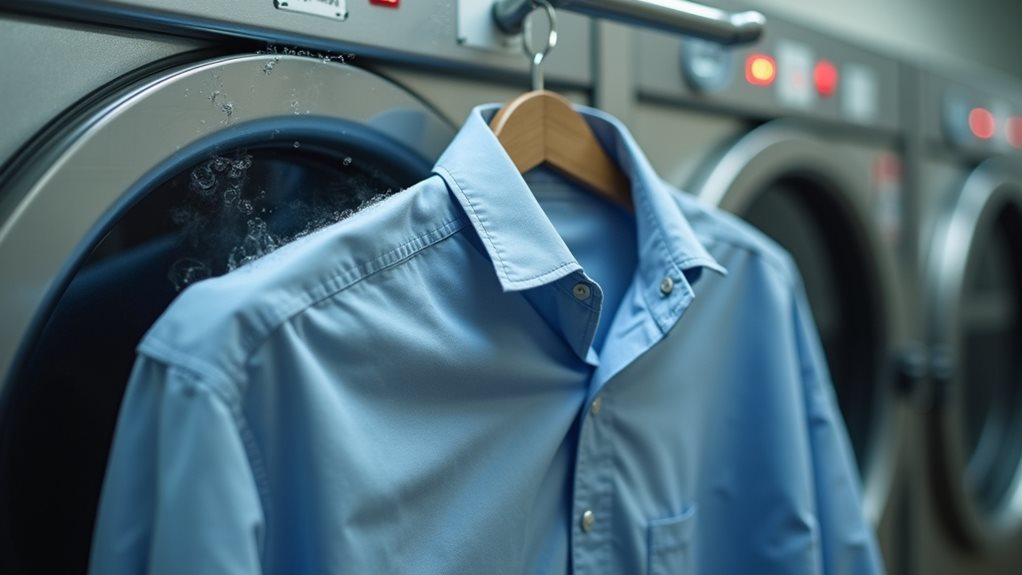
Even though dry cleaning solvents are gentler than water, equipment malfunctions can turn your favorite blazer into a miniature version that’d fit your nephew better than you.
I’ve witnessed this heartbreak firsthand when malfunctioning chillers caused overheating, shrinking my client’s designer suit beyond recognition 😅.
Here’s what typically goes wrong when dry cleaning equipment fails:
- Water leakage into solvents creates unexpected moisture that causes garments to contract
- Overheated solvents from broken chillers lead to fiber damage and shrinkage
- Poor maintenance schedules increase malfunction risks exponentially
- Inadequate quality control allows problems to go undetected until it’s too late
You can’t control equipment failures, but choosing facilities with rigorous maintenance programs protects your wardrobe investment and saves you from explaining why your pants suddenly became capris.
Beyond shrinkage concerns, equipment malfunctions can also lead to improper solvent removal, leaving PERC residues on your garments that pose potential health risks.
Comparing Shrinkage Risks: Dry Cleaning Vs Traditional Washing

While equipment failures can wreak havoc on your favorite garments, understanding how dry cleaning stacks up against traditional washing reveals why so many people choose professional care for their delicate pieces.
When you toss that wool sweater into your washing machine, you’re fundamentally playing shrinkage roulette—high temperatures and aggressive agitation create the perfect storm for fiber distortion.
Traditional washing’s combination of water and heat transforms your cotton shirts into unintentional crop tops, while dry cleaned garments dodge these pitfalls entirely.
The solvent-based process eliminates water-related shrinkage risks, gently coaxing dirt away without the brutal treatment your home washer dishes out.
Sure, professional cleaning costs more upfront, but you’ll save money avoiding those “oops, it shrunk” moments that send perfectly good clothes to donation bins.
Prevention Tips for Protecting Your Garments

Since I learned the hard way that my grandmother’s vintage silk blouse wasn’t meant for my “quick wash” experiment, I’ve become obsessed with reading every care label like it’s a treasure map to fabric preservation.
Trust me, those little symbols aren’t suggestions—they’re survival guides for your favorite pieces.
Those tiny care label symbols hold the secret to keeping your beloved garments looking fresh instead of becoming miniature mishaps.
Here’s how to prevent clothes from becoming expensive dollhouse outfits:
- Choose the best dry cleaner who specializes in delicate fabrics and communicates openly about their processes.
- Give special attention to vintage or expensive garments by discussing concerns upfront.
- Avoid over-dry cleaning since excessive heat exposure damages fibers over time.
- Skip hot water entirely for anything remotely delicate.
Proper storage matters too—hang suits, fold knits, and your wardrobe will thank you! 😊
Choosing the Right Professional Dry Cleaning Service

After my silk blouse disaster taught me that not all dry cleaners are created equal, I’ve developed a foolproof system for finding the right professional who won’t turn your favorite blazer into a crop top.
Start by researching customer reviews – you’ll quickly spot patterns about which dry cleaning service actually knows how to minimize shrinkage versus those who treat cashmere like cotton.
Look for cleaners who specialize in delicate fabric care and proudly advertise their eco-friendly techniques, since these gentler methods reduce heat damage that causes shrinkage.
When you visit, ask specific questions about their process for your fabric type – a knowledgeable cleaner will discuss fiber content and appropriate solvents rather than giving you a blank stare.

